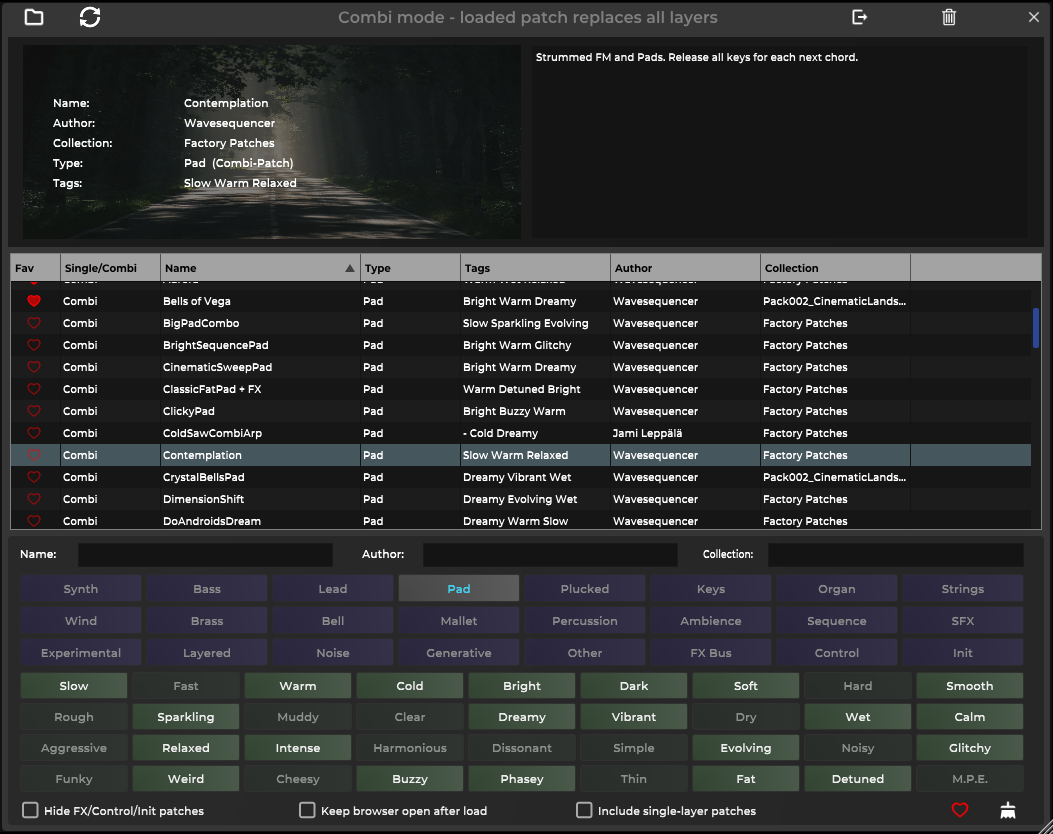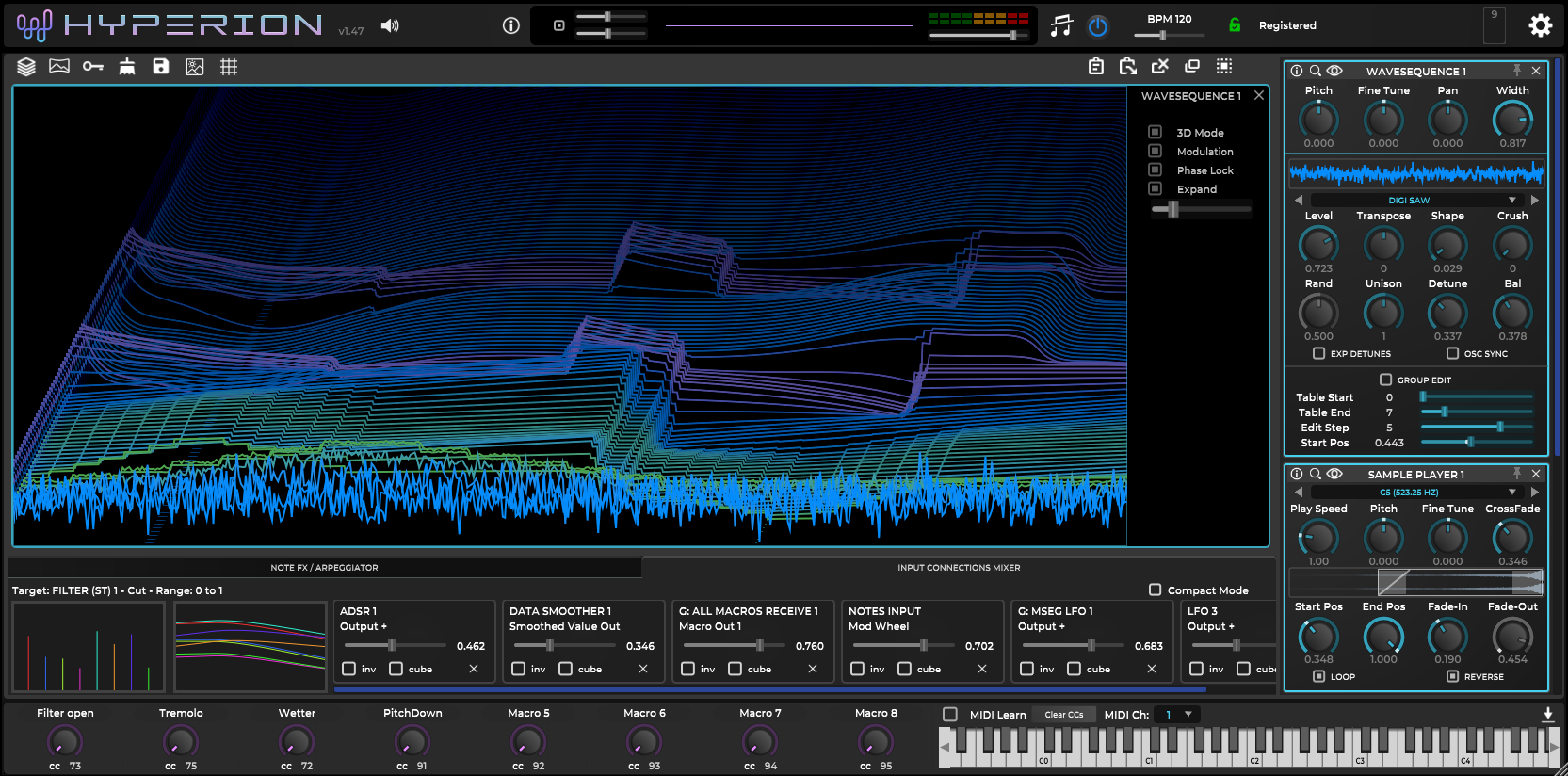

Hyperion is a powerful VST3/AU plugin and standalone synthesizer for Windows and Mac which features multiple synthesis types, totally flexible patching, and up to 16 layers of MPE capable polyphonic sounds with individual key and velocity zones, pitch bend ranges, tuning, arpeggiator and individual per-layer effects.
Modular audio nodes cover classic oscillators with wave-shaping and unison detunes with stereo spreading, wave-sequencing oscillators, 4 operator FM, wave-sequenced FM, a plucked string model, a flute model, sample playback, and sound-fonts (multi-samples).
Hyperion features multiple kinds of filters, distortions and bus effects as well as logic & math nodes for generative patch design.
Patches can have an unlimited number of nodes, and node control inputs can have multiple modulation sources allowing extremely complex modulations.
Auxiliary effect buses allow to send audio between layers, and control data and MIDI notes can also be sent from one layer to another allowing for deep modulation.
The number of sound processing elements is limited only by the available CPU power.
Deep modulation and layering possibilities
Hyperion synth has been designed from the outset with sonic flexibility in mind whilst keeping modular patching approachable and easy to follow.
Efficient processing enables up to 16 layers of complex sound patches which can be affected in unison by macro controls, but which can also send modulation data and aux buss audio between each other.
The ability to quickly layer and split polyphonic modular patches using a wide variety of synthesis methods and with individual chord, arpeggiation and bus effects per layer is an instant source of musical inspiration for music producers of all genres.
Multi-layer sound designs can be saved and recalled as ‘combi’ patches.
Patch browsing with categories and author filters as well as quick folder switching enables fast retrieval of sounds.
Hyperion features per layer note handling options enabling layer specific polyphony, pitch bend range, portamento speed, pitch randomization and drift depths, custom pitch slope (positive or negative), mono-phonic re-trig option, and voice trigger options.
Unlimited number of nodes per layer - and up to 16 mixable modulation sources per target modulation input pin.
Waveform previews, animated data modulation mix per-voice data bar and data-scope trace views, and in graph per voice text value and per-voice-data scope trace viewer nodes help to make complex patch designs easier to understand and adjust.
Multiple synthesis types
Classic mono and stereo ‘digital’ and ‘virtual analog’ oscillators with mono or stereo unison detuning and wave-shaping which enables drastic sonic character changes from the basic wave-forms. Integrated hard sync mode and waveform bit-crush controls.
Easy to use 4 operator FM (phase modulation with feedback) with 12 algorithms & multi-operator output mix, pre-selected list of useful modulation-operator ratios and master modulation depth control.
Wave-sequencing oscillators with up to 32 steps of oscillator configuration (including pitch offset, waveform, wave-shape depth, unison detunes, balance and level) with smooth cross fading via wave-sequence position modulation - save your own, and load ready made sequences.
Wave-sequenced 4 operator FM - with the same features as classic oscillator wave-sequencing but enabling sequences of 4 operator FM configurations (also with save and load capability).
Plucked string model with damping, distortion and stereo unison detunes.
Physical modeling flute oscillator with smooth note/pipe configuration transitions.
Sample playback with looping - can loop single cycle waveforms to create custom oscillator tones.
Multi-sample (sound font) oscillator enabling import of sf2 files.
Vector synthesis - modulate-able Vector mixers are available for both voice processing and FX-Bus audio processing (4 sources)
Sound processing
Per voice processing:
Multiple filter types including low/high/band/notch with cutoff & resonance, slope/depth, stereo offset and saturation control.
Distortion, Tube resonator, Ring modulator, Bit-Crusher, per-voice Granulator, Vowel filter.
Touch oriented modulate-able (4 source) audio levels and Vector-mixer nodes.
Suite of true-stereo buss effects including:
3 Reverb types: Medium, Large (with modulation and pre-delay), and Huge - all with size, damping, tone, and width controls.
Full and dual-band compressors with side-chain, gain and cross-over control.
Chorus, Flanger, Phaser, Tremolo.
Vowel Filter.
Stereo filter - with the full range of filter types.
Distortion/EQ’d-distortion.
3 Band EQ.
Tube Resonator, Ring mod, Bit-Crusher, Pitch shifter.
Stereo echo with cross feedback, L/R delay offset and damping controls.
Granulator (full range of emission rate/size/window/playback speed/mix controls).
FX bus send and receive (cross layer).
Touch oriented modulate-able (4 source) FX bus audio Vector-mixer node.
Huge range of control and data generation options
ADSR with pre-delay and multiple triggering options, looping envelope, LFOs with one-shot mode, beat sync and start phase control.
Macro data receive and sending (affecting all layers concurrently).
MIDI data/note sending and receiving on selected channels.
Sending control data from one layer to another on ‘internal MIDI’ channels.
Suite of data processing and generative nodes including data smoothing, binary logic, math expression evaluation, step sequences, data range mappers, scale mapping, event triggers, zone triggering, MIDI data triggering.
Send MIDI cc control data and notes to the outside world: drive other synths and effects on any of 16 MIDI channels.
XY-touch oriented data control trigger/data generator pads (nodes).
Hyperion features live waveform previews and envelope and filter curve previews that are affected by modulation inputs and settings.
Graphical control data viewers are place-able in the graph and, modulation values are animated on the knobs as well as the modulation sources mixer.
The expanded mode patch browser features dynamic instrument type and sound category toggle button filters to let you quickly find sounds.
The sample playback viewer shows the progression of active voices through the sample waveform, and shows the start/end/loop points as well as the cross-fade and fade in/out slope regions.
Cross-fading allows to seamlessly loop longer samples blending in the start whilst fading out the end section of the sample at the same time which is great for ambient background samples for example.
Single cycle samples can be set to looping mode and so can effectively behave more like a classic oscillator.
A Custom LFO drawing panel lets you hand draw or use spline curves to create custom beat-sync able LFOs which you can save and re-load to use in other LFO nodes - there is also a MSEG editor version of the LFO.
Widescreen mode puts the modulation and arp controls to the left of the node editing graph area for more vertical space.
The patch database and layers panels can be hidden and the macro controls minimized to save further space/concentrate on patch editing.
The oscillator waveform viewer 3D mode shows how oscillators cross-fade between wave-sequence steps, tone settings and how modulation sources affect the wave shape in real time with historical view that lets you better see how the sound is evolving.
Touch oriented control nodes allow multi-touch control of XY pad modulation and vector mixing.

System requirements / Specifications:
Mac 0SX 10.13+ (since Hyperion v1.45, previously 10.11), 64 bit (x86 and Apple Silicon), VST3/AU/Standalone (code-signed/notarized/registered Apple developer).
Windows 10+, 64 bit, VST3/Standalone (code-signed/registered Windows developer).
Recommended: 2018+ 4 or more core processor - minimum 8GB RAM (fully multi-core/multi-threaded voice processing - more cores the better).
Audio: Dedicated low latency audio interface highly recommended - 48KHz, 256 samples or lower buffer size recommended.
Storage requirements: Around 200 Mb disk space for installation, typically between 100Mb and 500Mb runtime RAM per instance - totally dependent on patch design/nodes usage.
VST3 distribution license approved by Steinberg.
See EULA for Ts&Cs.



















